Comparative Study of Computational Models for Reducing Air Pollution through the Generation of Negative Ions
Abstract
:1. Introduction
2. Materials and Methods
2.1. Air Purification System through Negative Ions
2.1.1. Design of Voltage Multiplier
2.1.2. Experimental Setup and Data Collection
- Gasoline: carbon dioxide, nitrogen oxide, carbon monoxide, and hydrocarbon molecules;
- Cigarette: nicotine, tar, arsenic, lead, polyaromatic hydrocarbons;
- Incense: carbon monoxide, sulfur dioxide, nitrogen oxide, and formaldehyde.
2.2. Computational Modeling of the Effects of Ionization in the Reduction of PM 2.5 Particles
2.2.1. Artificial Neural Networks (ANN)
2.2.2. The K-Nearest Neighbors (KNN) Model
2.2.3. Vector Support Machine (SVM)
2.2.4. Model Performance Measuring
- Root Mean Square Error (RMSE):
- Mean Absolute Error (MAE):
3. Results
3.1. Factorial Design of the Experiment
3.2. Comparison of the Obtained Computational Models
3.3. Discussion of Results
4. Conclusions
Author Contributions
Funding
Institutional Review Board Statement
Informed Consent Statement
Data Availability Statement
Conflicts of Interest
References
- Rojas Arenas, I.D. Del desarrollo económico al desarrollo económico endógeno: Una mirada desde el pensamiento complejo. Rev. Cintex 2018, 23, 12–23. [Google Scholar] [CrossRef]
- Ramanathan, V.; Feng, Y. Air pollution, greenhouse gases and climate change: Global and regional perspectives. Atmos. Environ. 2009, 43, 37–50. [Google Scholar] [CrossRef]
- Sahu, S.K.; Kota, S.H. Significance of PM2.5 air quality at the Indian capital. Aerosol Air Qual. Res. 2017, 17, 588–597. [Google Scholar] [CrossRef] [Green Version]
- Guaita, R.; Pichiule, M.; Maté, T.; Linares, C.; Díaz, J. Short-term impact of particulate matter (PM2.5) on respiratory mortality in Madrid. Int. J. Environ. Health Res. 2011, 21, 260–274. [Google Scholar] [CrossRef] [PubMed]
- Ortiz, C.; Linares, C.; Carmona, R.; Díaz, J. Evaluation of short-term mortality attributable to particulate matter pollution in Spain. Environ. Pollut. 2017, 224, 541–551. [Google Scholar] [CrossRef] [PubMed]
- Fajersztajn, L.; Saldiva, P.; Pereira, L.A.A.; Leite, V.F.; Buehler, A.M. Short-term effects of fine particulate matter pollution on daily health events in Latin America: A systematic review and meta-analysis. Int. J. Public Health 2017, 62, 729–738. [Google Scholar] [CrossRef] [PubMed]
- Liu, C.; Chen, R.; Sera, F.; Vicedo-Cabrera, A.M.; Guo, Y.; Tong, S.; Coelho, M.S.; Saldiva, P.H.; Lavigne, E.; Matus, P.; et al. Ambient particulate air pollution and daily mortality in 652 cities. N. Engl. J. Med. 2019, 381, 705–715. [Google Scholar] [CrossRef]
- Pope III, C.A.; Dockery, D.W. Health effects of fine particulate air pollution: Lines that connect. J. Air Waste Manag. Assoc. 2006, 56, 709–742. [Google Scholar] [CrossRef]
- Amri, F. Carbon dioxide emissions, output, and energy consumption categories in Algeria. Environ. Sci. Pollut. Res. 2017, 24, 14567–14578. [Google Scholar] [CrossRef]
- Choi, S.W.; Kim, B.H. Applying PCA to Deep Learning Forecasting Models for Predicting PM2.5. Sustainability 2021, 13, 3726. [Google Scholar] [CrossRef]
- Ventura, L.M.B.; Mateus, V.L.; de Almeida, A.C.S.L.; Wanderley, K.B.; Taira, F.T.; Saint’Pierre, T.D.; Gioda, A. Chemical composition of fine particles (PM2.5): Water-soluble organic fraction and trace metals. Air Qual. Atmos. Health 2017, 10, 845–852. [Google Scholar] [CrossRef]
- Cavalcante, R.M.; Rocha, C.A.; De Santiago, Í.S.; Da Silva, T.F.; Cattony, C.M.; Silva, M.V.; Silva, I.B.; Thiers, P.R. Influence of urbanization on air quality based on the occurrence of particle-associated polycyclic aromatic hydrocarbons in a tropical semiarid area (Fortaleza-CE, Brazil). Air Qual. Atmos. Health 2017, 10, 437–445. [Google Scholar] [CrossRef]
- Liu, W.; Huang, J.; Lin, Y.; Cai, C.; Zhao, Y.; Teng, Y.; Mo, J.; Xue, L.; Liu, L.; Xu, W.; et al. Negative ions offset cardiorespiratory benefits of PM2. 5 reduction from residential use of negative ion air purifiers. Indoor Air 2021, 31, 220–228. [Google Scholar] [CrossRef] [PubMed]
- Nadali, A.; Arfaeinia, H.; Asadgol, Z.; Fahiminia, M. Indoor and outdoor concentration of PM10, PM2. 5 and PM1 in residential building and evaluation of negative air ions (NAIs) in indoor PM removal. Environ. Pollut. Bioavailab. 2020, 32, 47–55. [Google Scholar] [CrossRef] [Green Version]
- Chen, P.; Wang, H.; Liu, H.; Ni, Z.; Li, J.; Zhou, Y.; Dong, F. Directional electron delivery and enhanced reactants activation enable efficient photocatalytic air purification on amorphous carbon nitride co-functionalized with O/La. Appl. Catal. B Environ. 2019, 242, 19–30. [Google Scholar] [CrossRef]
- Kubacka, A.; Fernandez-Garcia, M.; Colon, G. Advanced nanoarchitectures for solar photocatalytic applications. Chem. Rev. 2012, 112, 1555–1614. [Google Scholar] [CrossRef]
- Qian, X.; Fuku, K.; Kuwahara, Y.; Kamegawa, T.; Mori, K.; Yamashita, H. Design and functionalization of photocatalytic systems within mesoporous silica. ChemSusChem 2014, 7, 1528–1536. [Google Scholar] [CrossRef]
- Kwong, C.W.; Chao, C.Y.; Hui, K.S.; Wan, M.P. Removal of VOCs from indoor environment by ozonation over different porous materials. Atmos. Environ. 2008, 42, 2300–2311. [Google Scholar] [CrossRef]
- Waring, M.S.; Siegel, J.A.; Corsi, R.L. Ultrafine particle removal and generation by portable air cleaners. Atmos. Environ. 2008, 42, 5003–5014. [Google Scholar] [CrossRef]
- Bekö, G.; Fadeyi, M.O.; Clausen, G.; Weschler, C.J. Sensory pollution from bag-type fiberglass ventilation filters: Conventional filter compared with filters containing various amounts of activated carbon. Build. Environ. 2009, 44, 2114–2120. [Google Scholar] [CrossRef]
- Monpezat, A.; Topin, S.; Deliere, L.; Farrusseng, D.; Coasne, B. Evaluation methods of adsorbents for air purification and gas separation at low concentration: Case studies on xenon and krypton. Ind. Eng. Chem. Res. 2019, 58, 4560–4571. [Google Scholar] [CrossRef]
- Van Durme, J.; Dewulf, J.; Sysmans, W.; Leys, C.; Van Langenhove, H. Efficient toluene abatement in indoor air by a plasma catalytic hybrid system. Appl. Catal. B Environ. 2007, 74, 161–169. [Google Scholar] [CrossRef]
- Kowalski, W. Ultraviolet Germicidal Irradiation Handbook: UVGI for Air and Surface Disinfection; Springer Science & Business Media: New York, NY, USA, 2010. [Google Scholar] [CrossRef]
- Nishikawa, K.; Nojima, H. Air purification effect of positively and negatively charged ions generated by discharge plasma at atmospheric pressure. Jpn. J. Appl. Phys. 2001, 40, L835. [Google Scholar] [CrossRef]
- Xu, F.; Luo, Z.; Bo, W.; Zhao, L.; Gao, X.; Fang, M.; Cen, K. Experimental investigation on charging characteristics and penetration efficiency of PM2.5 emitted from coal combustion enhanced by positive corona pulsed ESP. J. Electrost. 2009, 67, 799–806. [Google Scholar] [CrossRef]
- Nunayon, S.S.; Zhang, H.H.; Jin, X.; Lai, A.C. Experimental evaluation of positive and negative air ions disinfection efficacy under different ventilation duct conditions. Build. Environ. 2019, 158, 295–301. [Google Scholar] [CrossRef]
- Huang, R.; Agranovski, I.; Pyankov, O.; Grinshpun, S. Removal of viable bioaerosol particles with a low-efficiency HVAC filter enhanced by continuous emission of unipolar air ions. Indoor Air 2008, 18, 106–112. [Google Scholar] [CrossRef]
- Černecký, J.; Valentová, K.; Pivarčiová, E.; Božek, P. Ionization impact on the air cleaning efficiency in the interior. Meas. Sci. Rev. 2015, 15, 156–166. [Google Scholar] [CrossRef] [Green Version]
- Shabani, B.; Hafttananian, M.; Khamani, S.; Ramiar, A.; Ranjbar, A.A. Poisoning of proton exchange membrane fuel cells by contaminants and impurities: Review of mechanisms, effects, and mitigation strategies. J. Power Sources 2019, 427, 21–48. [Google Scholar] [CrossRef]
- Guo, H.; Chen, J.; Wang, L.; Wang, A.C.; Li, Y.; An, C.; He, J.H.; Hu, C.; Hsiao, V.K.; Wang, Z.L. A highly efficient triboelectric negative air ion generator. Nat. Sustain. 2021, 4, 147–153. [Google Scholar] [CrossRef]
- Sawant, V.; Meena, G.; Jadhav, D. Effect of negative air ions on fog and smoke. Aerosol Air Qual. Res. 2012, 12, 1007–1015. [Google Scholar] [CrossRef]
- Pushpawela, B.; Jayaratne, R.; Nguy, A.; Morawska, L. Efficiency of ionizers in removing airborne particles in indoor environments. J. Electrost. 2017, 90, 79–84. [Google Scholar] [CrossRef]
- Jiang, S.-Y.; Ma, A.; Ramachandran, S. Negative Air Ions and Their Effects on Human Health and Air Quality Improvement. Int. J. Mol. Sci. 2018, 19, 2966. [Google Scholar] [CrossRef] [Green Version]
- Berendt, A.; Budnarowska, M.; Mizeraczyk, J. DC negative corona discharge characteristics in air flowing transversely and longitudinally through a needle-plate electrode gap. J. Electrost. 2018, 92, 24–30. [Google Scholar] [CrossRef]
- Maennel, C.G. Improvement in the modelling of a half-wave Cockroft-Walton voltage multiplier. Rev. Sci. Instrum. 2013, 84, 064701. [Google Scholar] [CrossRef] [PubMed]
- Terrés-Speziale, A.M. Manejo de la contaminación ambiental intramuros por medio de la generación de iones aéreos electronegativos. Rev. Mex Patol Clin. Med. Lab. 2006, 53, 29–38. [Google Scholar]
- Guzmán, A.A.E.; Tzuc, O.M.; Pantí, I.B.; Trujeque, J.R.; Quintana, I.V.P.; Bassam, A. Modelado de partículas PM10 y PM2.5 mediante redes neuronales artificiales sobre clima tropical de San Francisco de Campeche, México. Química Nova 2017, 40, 1025–1034. [Google Scholar] [CrossRef]
- May Tzuc, O.; Bassam, A.; Escalante Soberanis, M.A.; Venegas-Reyes, E.; Jaramillo, O.A.; Ricalde, L.J.; El Hamzaoui, Y. Modeling and optimization of a solar parabolic trough concentrator system using inverse artificial neural network. J. Renew. Sustain. Energy 2017, 9, 013701. [Google Scholar] [CrossRef]
- Hmoud Al-Adhaileh, M.; Waselallah Alsaade, F. Modelling and Prediction of Water Quality by Using Artificial Intelligence. Sustainability 2021, 13, 4259. [Google Scholar] [CrossRef]
- García Nieto, P.J.; Combarro, E.F.; del Coz Díaz, J.J.; Montañés, E. A SVM-based regression model to study the air quality at local scale in Oviedo urban area (Northern Spain): A case study. Appl. Math. Comput. 2013, 219, 8923–8937. [Google Scholar] [CrossRef]
- Willmott, C.J.; Matsuura, K. Advantages of the mean absolute error (MAE) over the root mean square error (RMSE) in assessing average model performance. Clim. Res. 2005, 30, 79–82. [Google Scholar] [CrossRef]
- Douglas, M. Diseño y Análisis de Experimentos; Limusa Wiley: Segunda Edición, Mexico, 2002. [Google Scholar]
- Ferré, J. El Diseño Factorial Completo 2k. Bachelor’s Thesis, Universidad Rovira i Virgili, Catalonia, Spain, 2005. [Google Scholar]
- Ma, J.; Ding, Y.; Cheng, J.C.; Jiang, F.; Wan, Z. A temporal-spatial interpolation and extrapolation method based on geographic Long Short-Term Memory neural network for PM2.5. J. Clean. Prod. 2019, 237, 117729. [Google Scholar] [CrossRef]
- Tian-Cheng, M.A.; Liu, D.M.; Xue-Jie, L.I. Improved particle swarm optimization based fuzzy neural network for PM_ (2.5) concentration prediction. Comput. Eng. Des. 2014, 35, 3258–3262. [Google Scholar]
- Zhu, H.; Lu, X. The prediction of PM2.5 value based on ARMA and improved BP neural network model. In Proceedings of the International Conference on Intelligent NETWORKING and Collaborative Systems, Ostrawva, Czech Republic, 7–9 September 2016; IEEE: Piscataway, NJ, USA, 2016; pp. 515–517. [Google Scholar] [CrossRef]
- Zhou, S.; Li, W.; Qiao, J. Prediction of PM2.5 concentration based on recurrent fuzzy neural network. In Proceedings of the Control Conference, Seattle, WA, USA, 24–26 May 2017; IEEE: Piscataway, NJ, USA, 2017; pp. 3920–3924. [Google Scholar] [CrossRef]

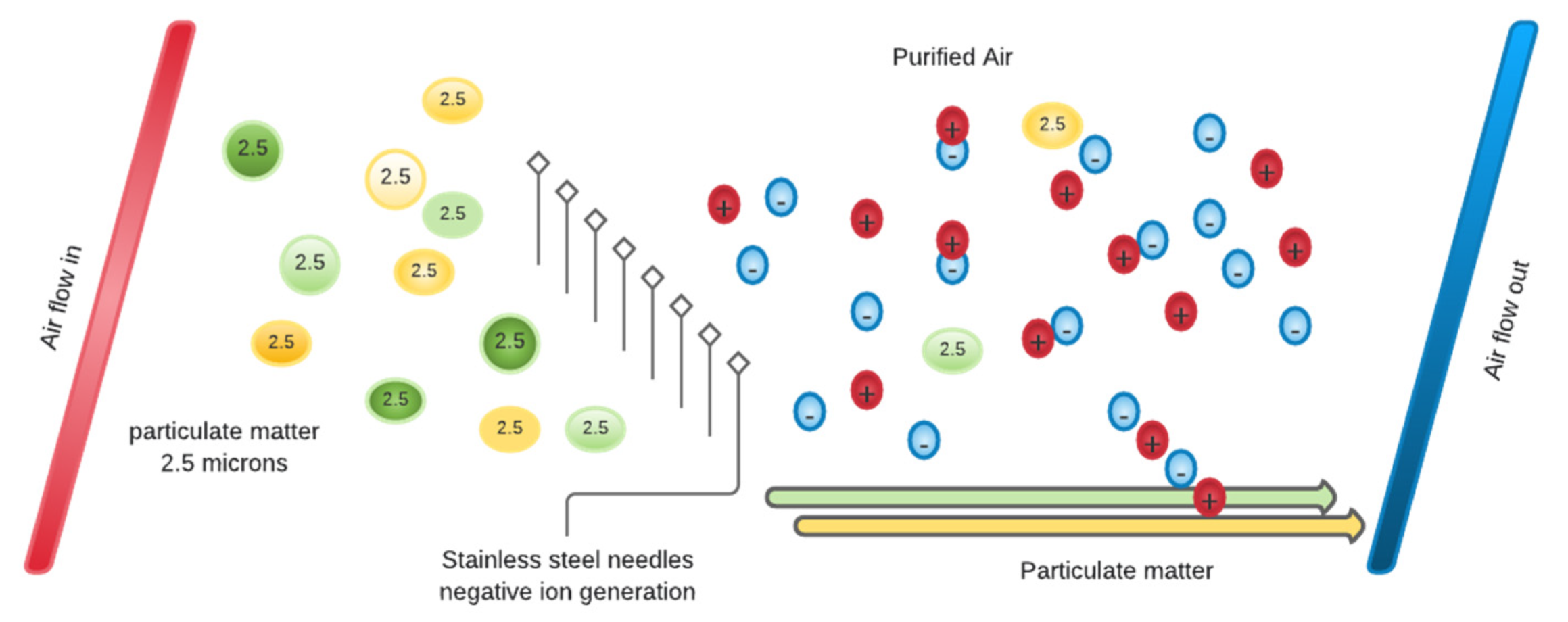


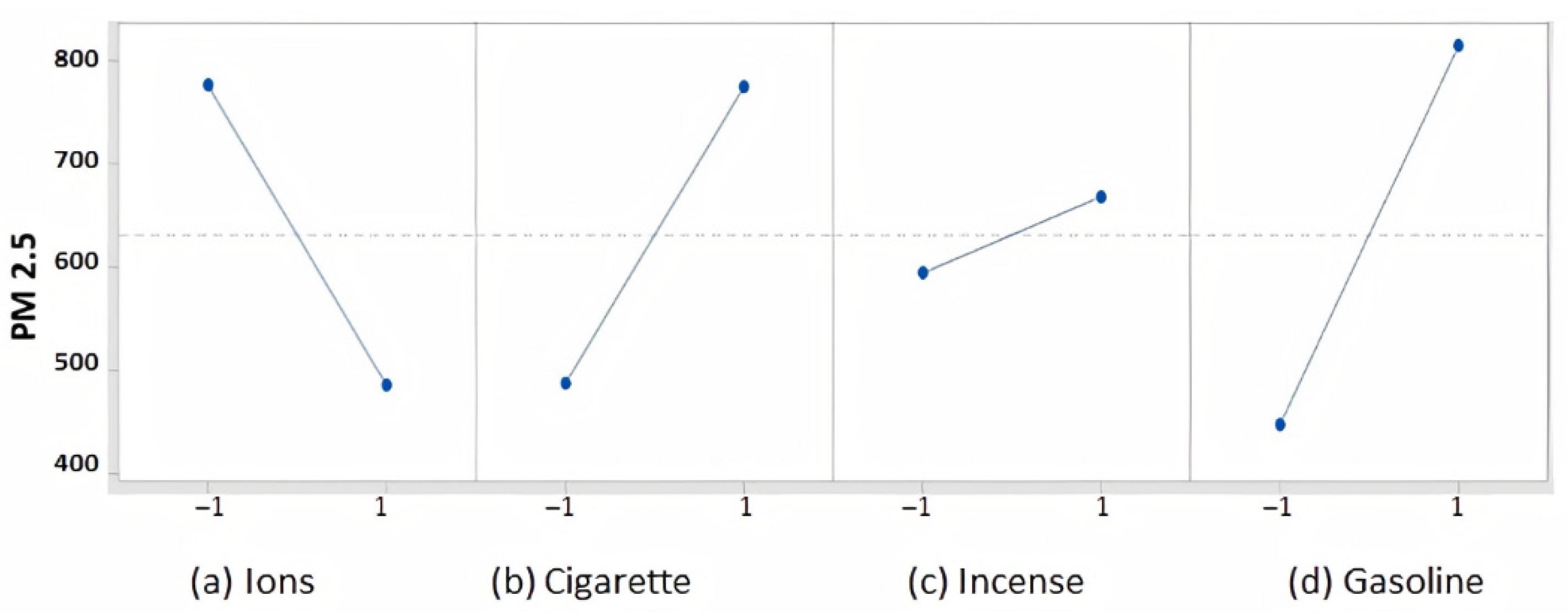
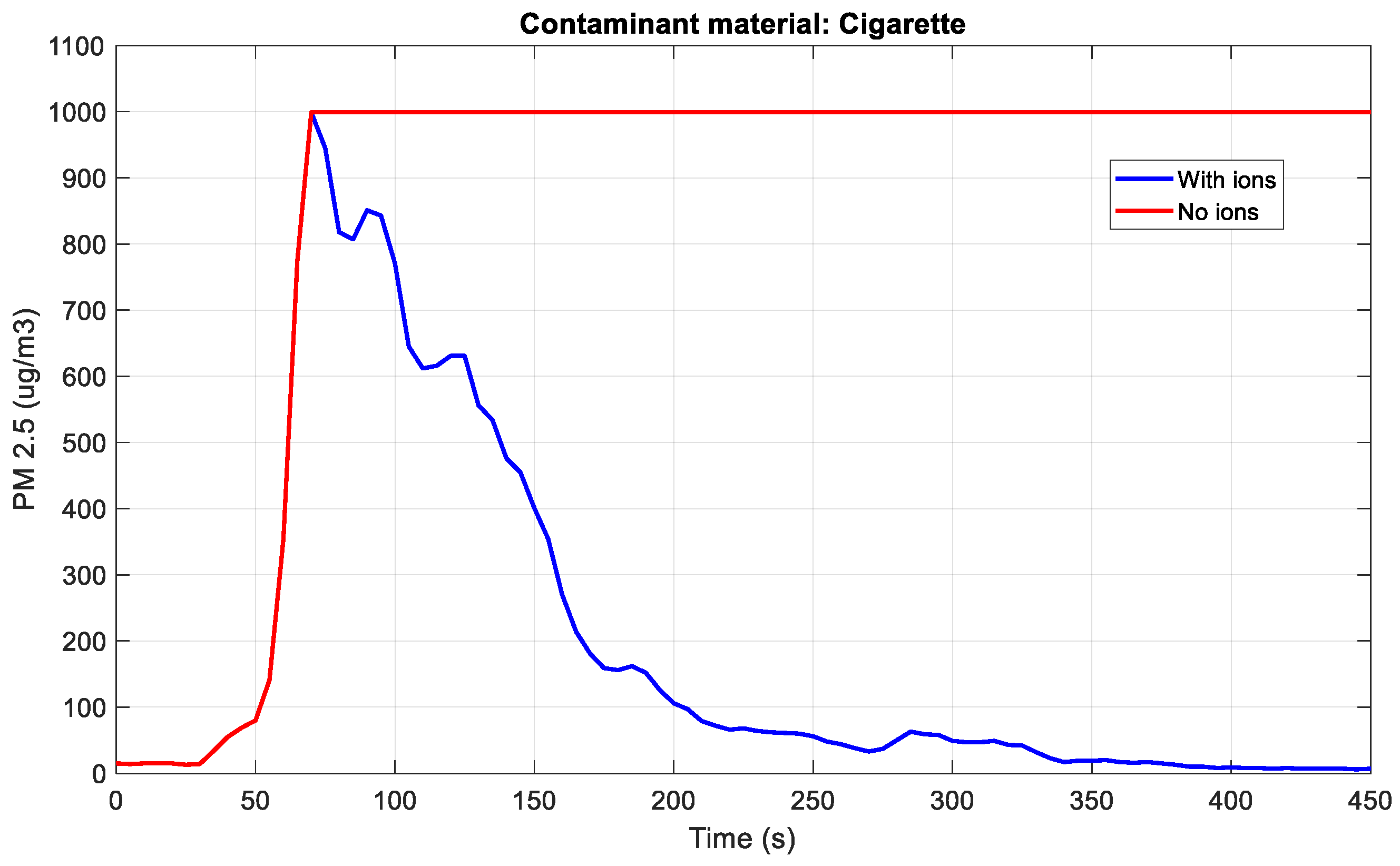
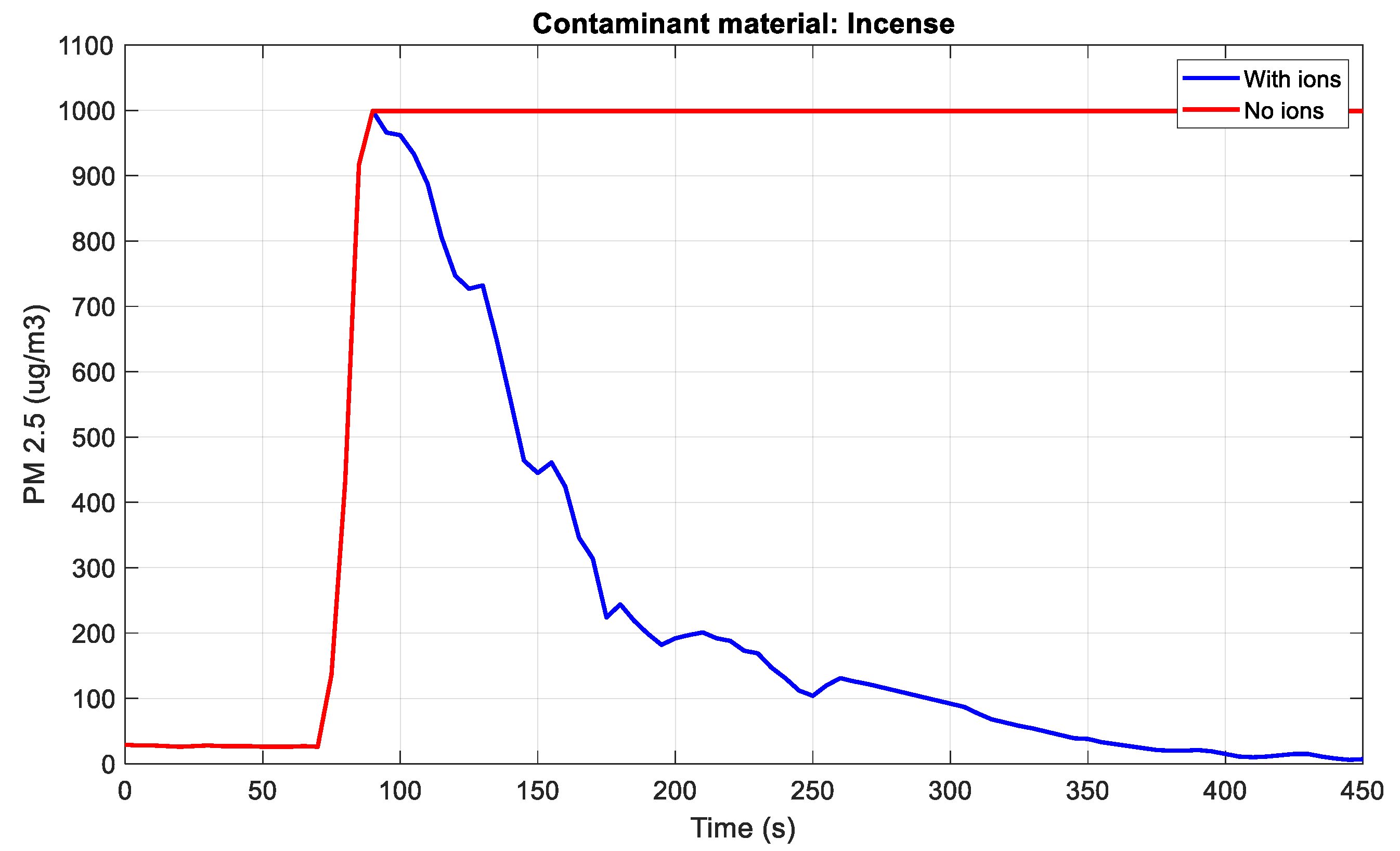


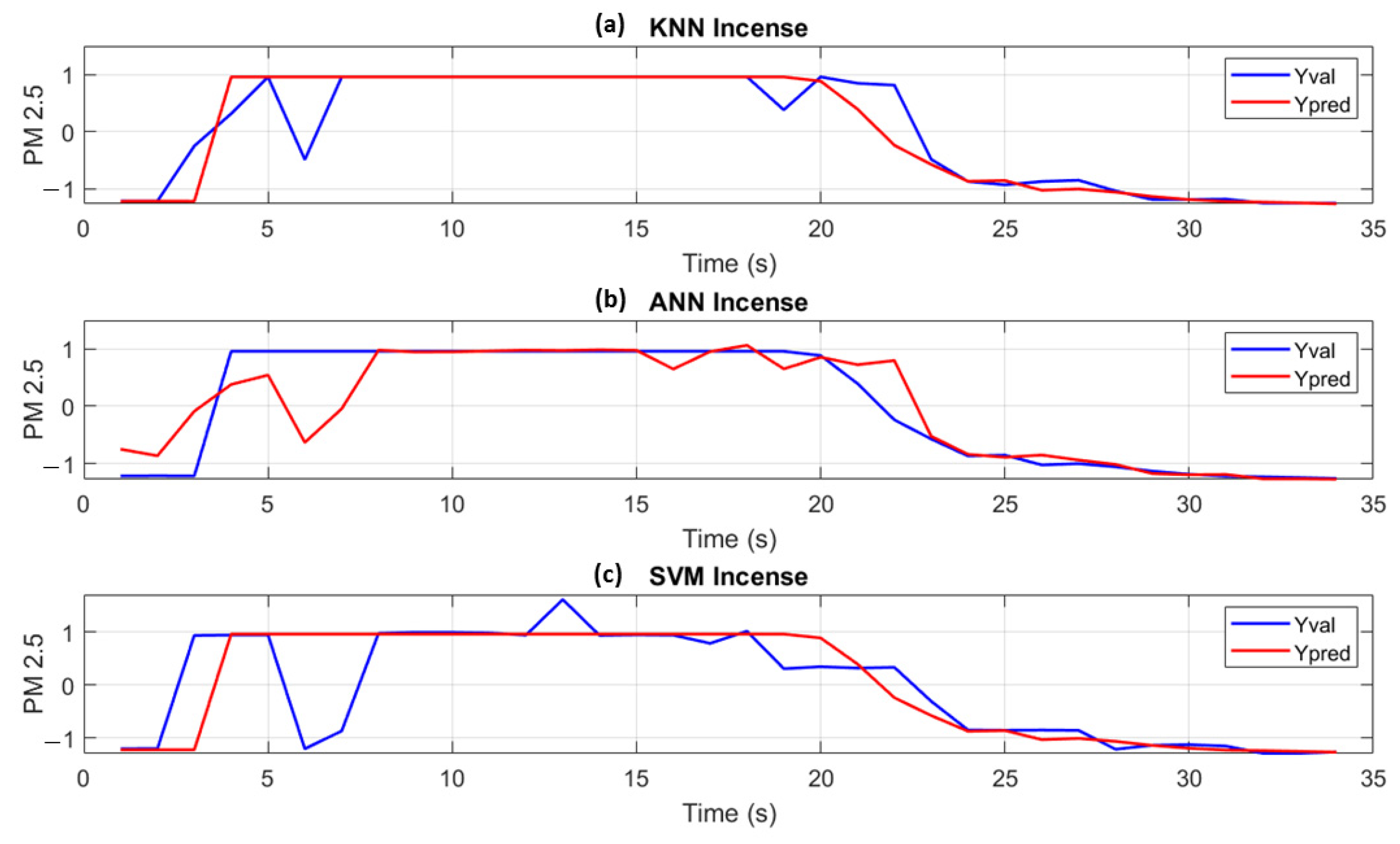

| Pollutant | Method | RMSE Error | MAE Error |
|---|---|---|---|
| Cigarette | ANN | 0.3957 | 0.1915 |
| KNN | 0.3906 | 0.1733 | |
| SVM | 0.4746 | 0.2594 | |
| Incense | ANN | 0.4758 | 0.4511 |
| KNN | 0.3900 | 0.1718 | |
| SVM | 1.1167 | 0.5616 | |
| Gasoline | ANN | 0.4636 | 0.2426 |
| KNN | 0.4615 | 0.1925 | |
| SVM | 0.5298 | 0.4092 |
Publisher’s Note: MDPI stays neutral with regard to jurisdictional claims in published maps and institutional affiliations. |
© 2021 by the authors. Licensee MDPI, Basel, Switzerland. This article is an open access article distributed under the terms and conditions of the Creative Commons Attribution (CC BY) license (https://creativecommons.org/licenses/by/4.0/).
Share and Cite
Ortiz-Grisales, P.; Patiño-Murillo, J.; Duque-Grisales, E. Comparative Study of Computational Models for Reducing Air Pollution through the Generation of Negative Ions. Sustainability 2021, 13, 7197. https://doi.org/10.3390/su13137197
Ortiz-Grisales P, Patiño-Murillo J, Duque-Grisales E. Comparative Study of Computational Models for Reducing Air Pollution through the Generation of Negative Ions. Sustainability. 2021; 13(13):7197. https://doi.org/10.3390/su13137197
Chicago/Turabian StyleOrtiz-Grisales, Paola, Julián Patiño-Murillo, and Eduardo Duque-Grisales. 2021. "Comparative Study of Computational Models for Reducing Air Pollution through the Generation of Negative Ions" Sustainability 13, no. 13: 7197. https://doi.org/10.3390/su13137197
APA StyleOrtiz-Grisales, P., Patiño-Murillo, J., & Duque-Grisales, E. (2021). Comparative Study of Computational Models for Reducing Air Pollution through the Generation of Negative Ions. Sustainability, 13(13), 7197. https://doi.org/10.3390/su13137197






